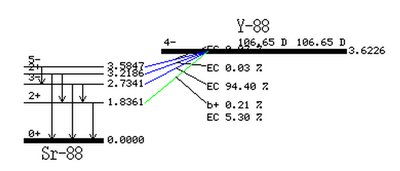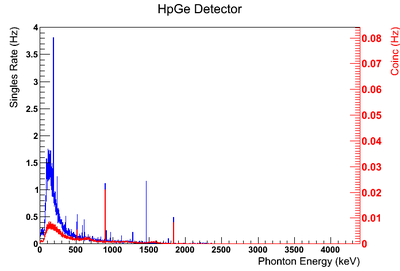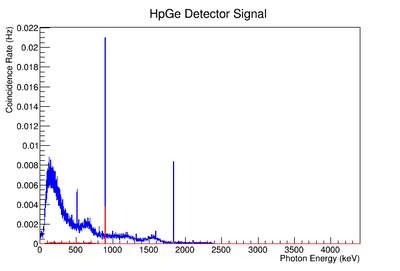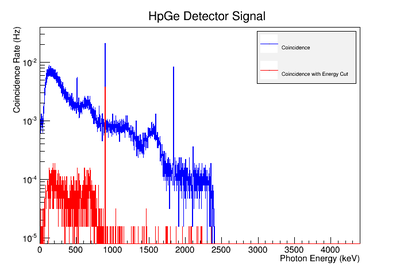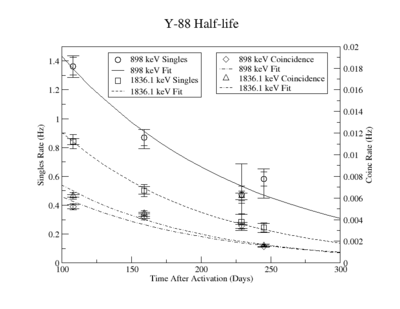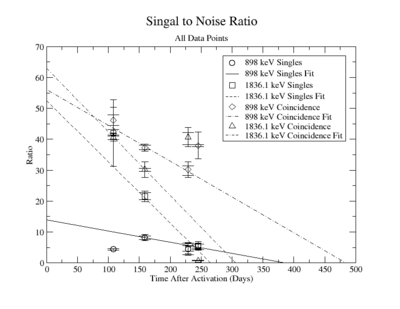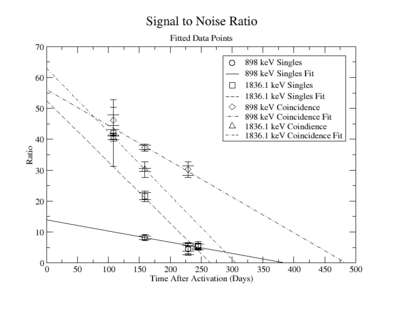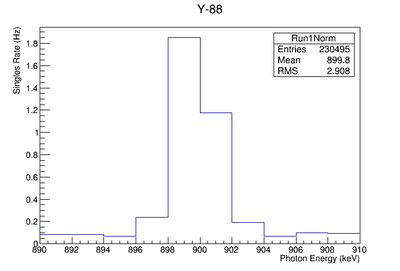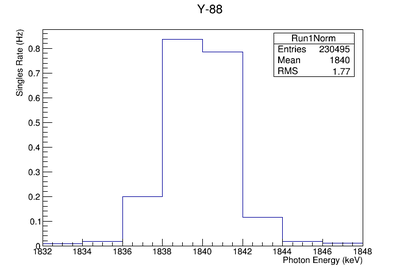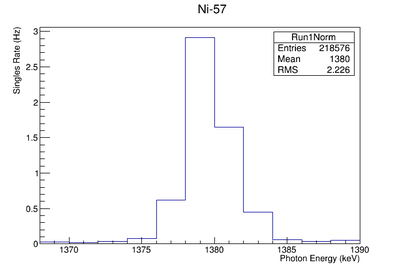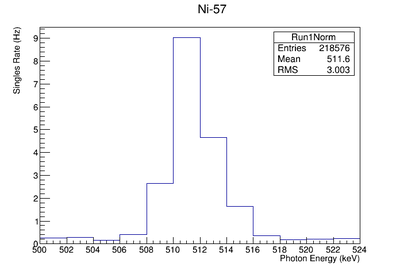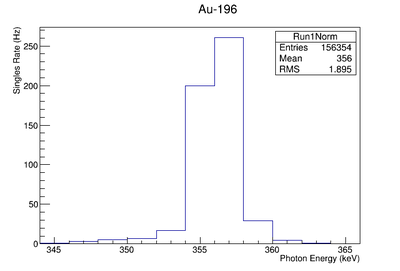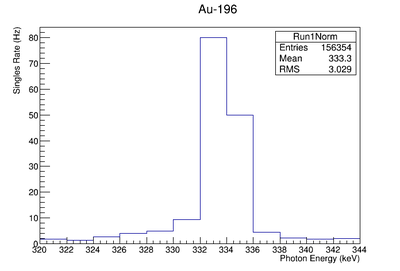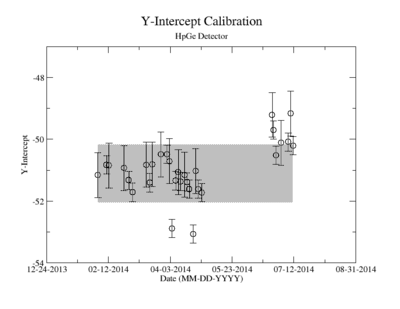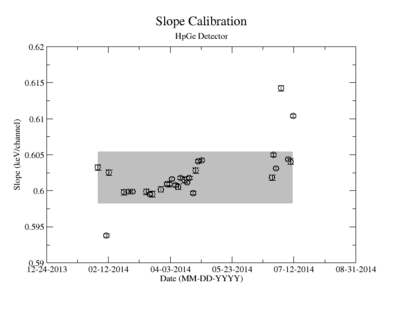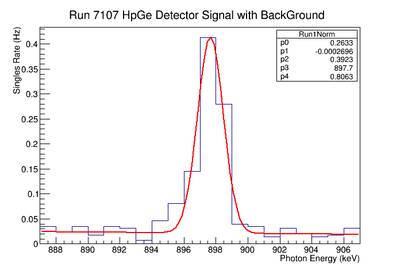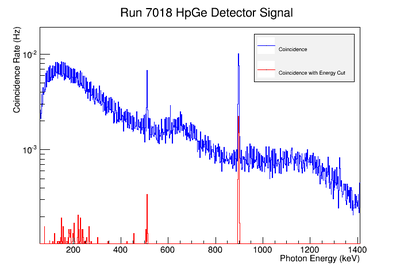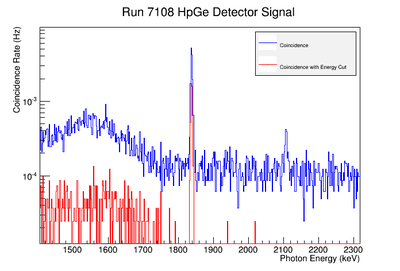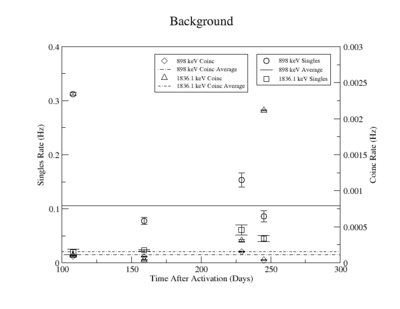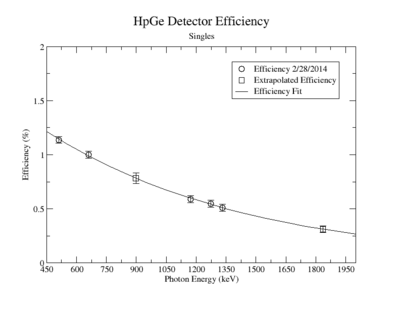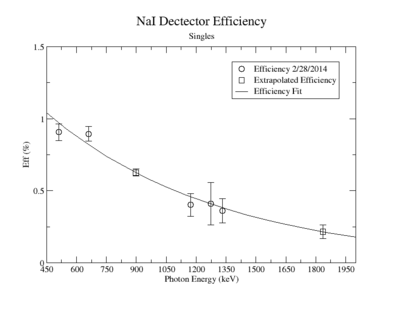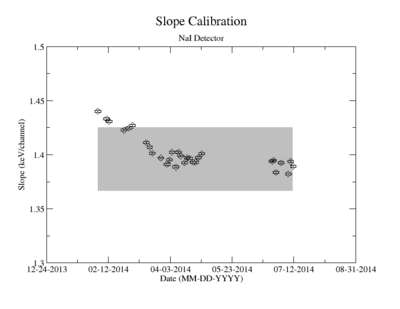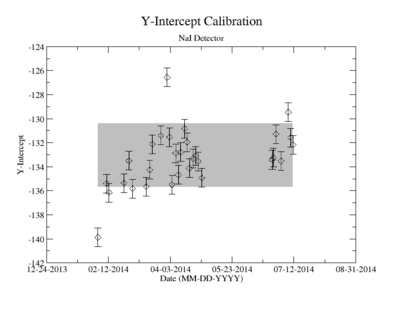Difference between revisions of "A W thesis"
| Line 356: | Line 356: | ||
|} | |} | ||
| − | <math>t_i</math> = 5 hr =18000 s | + | :<math>t_i</math> = 5 hr =18000 s |
| − | <math>t_d</math> = 5 days = 432000 s | + | :<math>t_d</math> = 5 days = 432000 s |
Revision as of 16:31, 13 November 2014
Y-88 source #130113-004
Foil weight: 0.0496 +/- 0.0002 g
Foil # of atoms: 3.398e20 +/- 1.37e18 atoms
Here we have: P = E I
Here, [P] Watts, [E] MeV, and [I] A
- Accelerator Settings
| beam energy | 22 MeV |
| Rep Rate: | 170 Hz |
| I_peak: | 80 mA/pulse |
| pulse width: | 4 s |
Time on for one second is 1 us. and Time off is 0.999999 s The average current 0.999999 * 0 + 0.000004*170*80mA = 54.4 A.
P = (22 MeV) (54.4 A) = 1.2 k Watt.
Introduction
Methods of Determining Atomic Concentration in Material
Inductively coupled plasma mass spectrometry(ICP-MS)
Inductively coupled plasma mass spectrometry (ICP-MS) is an elemental analytical technique with detection limits from ppm by combining a high-temperature ICP plasma with a mass spectrometer. A sample is introduced into the ICP plasma, typically as an aerosol, where it ionizes the sample's atoms. The ions are then brought into the mass spectrometer and focused by electrostatic lenses in the system. Once in the mass spectrometer, the ions are separated by their mass-to-charge ratio. The most commonly used type of mass spectrometer is the quadrupole mass filter. The ability to filter ions this way allows the ICP-MS to supply isotopic information, since different isotopes of the same element have different masses. Once the ions have been separated by their mass-to-charge ratio, they must then be detected or counted by a suitable detector. A channel electron multiplier (CEM) was used in early ICP-MS instrumentation, however, this open glass cone coated with semi-conductor has since been replaced with discrete metal dynode type detectors. The electrical signal from the detector is measured and related to the number of atoms of that element in the sample with the use of calibration standards.
https://www.uam.es/personal_pas/txrf/imagenes/tutorial10.pdf
Inductively coupled plasma atomic emission spectroscopy(ICP-AES)
Inductively coupled plasma atomic emission spectroscopy (ICP-AES) is sometimes referred to as ICP-OES, meaning 'optical emission spectrometry'. It is an analytical technique used for the detection of trace metals to within ppm. Similar to ICP-MS, it utilizes the ICP plasma to produce exited atoms and ions that will emit electromagnetic radiation at wavelengths characteristic of a particular element. The concentrations of the elements within a sample can be determined based on the intensity of the emissions. The ICP-AES is composed of a ICP and the optical spectrometer. As with ICP-MS, a liquid or organic sample is injected into the hot plasma torch, where compounds are usually completely dissociated. The excited atoms and ions emit radiation at characteristic lines which are focused onto a diffraction grating and slit system where it is dispersed into its component wavelengths in the optical spectrometer. The photomultiplier tubes previous used to measure the light intensity have been replaced by an array of semiconductor photodetectors such as solid state charge-coupled devices (CCDs). The intensity of each line is compared to previously measured intensities of known concentrations of the elements in order to calibrate the system.
Atomic Absorption Spectrometry (multi-element AAS)
Atomic absorption spectrometry (AAS) is a spectra-analytical procedure used for the determination of elements to within ppm by using the absorption of optical radiation by the atoms. AAS can be used to determine over 70 different elements in solution, but the technique can only measure one element at a time. In order to analyze an element, a liquid sample must be atomized into a vapor. The most common atomizers are flames and electrothermal graphite tube atomizers. Since AAS basic mode of operation is absorption, as opposed to emission, optical radiation that is characteristic of the element to be determined is passed through the sample vapor. A hollow cathode lamp is the most common radiation source in AAS, and most machines utilize two lamps to cover more elements. The radiation then passes into a monochromator, either a prism or diffraction grating, followed by a slit in order to separate the element-specific radiation from any other radiation emitted by the radiation source. The optical radiation is then transmitted to a photomultiplier detector to convert the light into an electrical current.
Particle-induced X-ray Emission (PIXE)
Particle-induced X-ray Emission (PIXE) is a non-destructive analytical technique used in determining elemental composition of a material or sample. It has detection limits typically around ppm. The particle beam most often used for PIXE is a positive ion beam. Three types of spectra can be collected using PIXE: X-ray emission spectrum, Rutherford backscattering spectrum, and proton transmission spectrum. The proton beam strikes a sample, which causes inner shell vacancies. The outer shell electrons de-excite to replace, or fill, the inner shell vacancies, emitting radiation in the X-ray portion of the electromagnetic spectrum. The energy of the emitted photon characteristic of the atom. These emissions are detected using energy-dispersive detectors. Protons in the ion beam will also experience elastic collisions, Rutherford backscattering, with the nucleus of the atom. The backscatter can give composition information on the sample and allow for correction of the X-ray photon loss within the sample. Proton transmission can further provide information about the sample.
X-ray Fluorescence Spectrometry (XRF)
X-ray Fluorescence Spectrometry (XRF) is an analytical technique used for elemental analysis, particularly in the investigation of metals, glass, and ceramics. In XRF, the primary X-Rays are most commonly produced by an X-ray tube and have detection limits around ppm. However, alternative primary sources include synchrotron radiation, with reported detection limits of 100 ppm or better, can be used. The synchrotron is a large electron accelerator which produces electromagnetic radiation across the whole spectrum, with high spectral purity and high beam intensity. Desired sections of the spectrum can be selected and focused while retaining beam intensity. This beam can then be used as the primary beam in XRF analysis. Once the primary X-rays strike the solid sample, two processes occur, scattering and absorption. Vacancies are created in the orbital shell of the sample atoms as a result of energy absorption and the ejection of an electron. The removal of an electron makes the structure of the atom unstable, and electrons in higher orbitals will de-excite to the lower orbital to fill the vacancy. During the change in orbital, radiation is emitted with energy characteristic of the atom present. This secondary radiation from the sample can be analyzed with two different approaches, energy-dispersive or wavelength-dispersive analysis. In energy-dispersive analysis, various types of solid state detectors are used to collect the incoming X-ray photon, while wavelength-dispersive analysis employs a monochromator and a photomultiplier for detection of a single wavelength of radiation.
10-100 PPM using Xray tubes
100 ppm or better using synchrotron
Methods of Determining Nuclei in Material
Nuclei of stable elements can become radioactive when they undergo an inelastic collision that results in the addition or removal of a nucleon or several nucleons from the nucleus. Nuclei are usually left in an unstable state and will almost instantaneously de-excite into a more stable configuration. This process involves the prompt emission of particles or photons. If the initial nucleus to be activated is denoted by , the incident radiation particle as a, and the product nuclide and promptly emitted particles are denoted by and b respectively, the reaction can be represented by the equation
or, in the abbreviated form
.
The type of the nuclear reaction depends upon the target nucleus and the nature and energy of the incident radiation. Many of these product radioactive nuclei decay through and subsequent emission. The -rays are characteristic of that particular decay process. By precise determination of the -ray energies it is usually possible to determine not only which isotopes are present, but from the intensities it can be determined exactly how much of the original target nucleus was present and consequently the amount of that element present in the sample. The use of neutrons and photons as the activating radiation particle are outlined below.
Neutron Activation Analysis (NAA)
Neutron activation analysis (NAA) is a non-destructive technique used to measure trace elements in materials with detection limits of ppm. In NAA, the incident radiation particle is a neutron. There are range of different neutron sources available, but only a few that offer the high neutron fluxes useful for NAA. These include reactors and accelerators. Since they have high fluxes ( ) of neutrons from uranium fission, nuclear reactors offer the highest available sensitivities for most elements. The sequence of events taking place during the most common type of nuclear reaction for NAA, namely neutron capture (n,), is illustrated in figureXX.YY.
Upon irradiation, a neutron is absorbed the target nucleus. The compound nucleus transitions to an excited and unstable state. This unstable nucleus de-excites into a more stable configuration by emitting one or more prompt gamma rays. In most cases, this new configuration tends to be a longer lived radioactive nucleus. The newly formed radioactive nucleus now decays by the emission of one of more characteristic delayed gamma rays. The half-life of this decay is unique to the radioactive nucleus. An NAA measurement, in principle, falls into two categories: (1) prompt gamma-ray neutron activation analysis (PGNAA), where measurements are taken during the irradiation of a sample, or (2) the more common delayed gamma-ray neutron activation analysis (DGNAA), where measurements follow radioactive decay.
There are several types of detectors employed in NAA. Most are designed to detect the emitted radiation. The detectors most commonly used are scintillation type, with radiation sensitive crystals such as thallium-doped sodium iodide (NaI(Tl)), or semiconductor type detectors. Hyper-pure or intrinsic germanium (HpGe) detectors are the semiconductor type most commonly operated for NAA.
Photon Activation Analysis (PAA)
In photon activation analysis (PAA), nuclei in the sample material are excited into radioactive meta-stable states through exposure to high-energy (MeV) photons and has a detection limit of XXXX. The photon source is typically produced by accelerating electrons onto a target layer of metal with a high atomic number, such as tungsten. The de-acceleration of electrons passing through the target (radiator) produces electromagnetic radiation. Such radiation is referred to as bremsstrahlung radiation. If the bremsstrahlung radiation strikes a sample nucleus and causes results in the removal of a nucleon from the nucleus, the nucleus will more often than not be left in an excited state. The resulting nucleus may be unstable and de-excite by prompt emission of alpha, beta, or gammas. The energy of the emitted radiation is usually characteristic of the nuclide. A measurement of the gamma energy can thus be used to identify the nuclear isotope. Similar to NAA, gamma radiation is commonly measured using scintillation type, with radiation sensitive crystals such as thallium-doped sodium iodide (NaI(Tl)), or semiconductor type, such as HpGe detectors.
Y-88:
http://physics.nist.gov/cgi-bin/Xcom/xcom3_1-t
| Energy (keV) | Relative Intensity |
| 850.6 | 0.065 |
| 898.042 | 93.7 |
| 1382.2 | 0.021 |
| 1836.063 | 99.2 |
| 2734.0 | 0.71 |
| 3219.7 | 0.0070 |
| Energy (keV) | Coincidence gamma |
| 850.6 | 898.042, 1836.063, 2734.0 |
| 898.042 | 850.6, 1836.063 |
| 1382.2 | 1836.063 |
| 1836.063 | 850.6, 898.042, 1382.2 |
| 2734.0 | 850.6 |
| 3219.7 |
http://www.nndc.bnl.gov/chart/decaysearchdirect.jsp?nuc=88Y&unc=nds
| Energy (keV) | Decay Time (ps) |
| 898.042 | 0.70 |
| 1836.063 | 0.154 |
http://www.nndc.bnl.gov/chart/getdataset.jsp?nucleus=88SR&unc=nds
The only natural occurring isotope of yttrium is Y-89. During photon activation of a yttrium foil, a neutron is removed from the nucleus in a reaction. The resulting Y-88 is radioactive with a half-life of 106.6 days. TableXX.YY gives the photon lines for a Y-88 sample. The 898 keV and 1836.1 keV lines have been observed to be the most prevalent with relative intensities of 93.7% and 99.2%. TableXX.YY provides a list of Y-88 photons with the gammas they are in coincidence with. Note that the 898 keV and 1836.1 keV lines are also in coincidence. This coincidence occurs when the 2734.1 keV state, which occurs 94% of the time, makes a transition after 0.7 ps to the 1836.1 keV state, emitting a 898 keV photon. The 1836.1 keV state will decay to the ground state after 0.154 ps and emit a 1836.1 keV photon. A diagram of the photon energies and their transitions can be seen in figureXX.YY. The total lifetime of the transitions is less than a picosecond. For our experimental setup, discussed in sectionXX.YY, the coincidence timing window was set to 200 ns, so for effective purposes the 898 keV and 1836.1 keV photons are considered in coincidence and will be used for our PAA analysis.
Y-89:
Binding Energy: 775538.048 +- 2.349 keV
http://www.tandfonline.com/doi/pdf/10.1080/18811248.2010.9720959
File:Y-89 N-knockout-Xsect JNS 2010 Kalam.pdf
table of detection limits -vs- Method
| Method | Detection Limit (ppm) |
| ICP-MS | |
| ICP-AES | |
| AAS | 1-100 |
| ()PIXE | (1-20) 0.5-5 |
| (S)XRF | (100 or better) 3-20 |
| NAA | 0.01-10 |
| PAA |
Coincidence Counting Setup
Y-88 CAA
Using our Y-88 source, our set-up allows us to perform runs with the detectors in coincidence (AND mode) or singles (OR mode). The figure on the left shows the HpGe detector's coincidence events (red) that occurred within a 200 ns timing window. This graph has been overlaid with the same detector’s single events (blue). We can see that by having the detectors in coincidence, the noise is reduced and several peaks, which do not have multiple photons in coincidence, are removed.
The coincidence run does not show the two energy peaks associated with Y-88 decay alone. Even though we require coincidence for the system to trigger, there is still noise. These peaks could be Compton events contaminating the coincidence and accidentals. Photons can loss a portion of their energy traveling to the detector. They do not necessarily have to deposit all of their energy into the detector either. The photon can Compton scatter out. It is not possible to tell the difference between a photon that deposited all of its energy from a scattered photon, since the speed of light is so fast and the resolution of the detector so poor. The photons can, however, be distinguished if an energy cut is applied. In order to remove the Compton events and the accidentals, we can require the photon energy to be completely deposited into the detector. This can be achieved by placing an energy cut on the NaI detector around the high energy Y-88 peak. This will remove other unwanted photon energies. The graph on the right is an overlay of the coincidence signal before (blue) and after (red) an energy cut is applied to the companion detector (NaI detector). The noise seen at low energies is greatly reduced after including the cut and improved the signal.
Background subtraction
898 keV analysis
The raw Histograms and fits may be found here A_W_thesis_old#898_keV_signal_table
The Measured half life is
| Days | Trig | Integral | Statistical Error | Systematic Error | Systematic Error without Coincidence Energy Cut | |
| 108 | 1.01 | sing | 1.364 | N/A | ||
| coin | 0.0052 | |||||
| 159 | 1.49 | sing | 0.8697 | N/A | ||
| coin | 0.0042 | |||||
| 229 | 2.15 | sing | 0.4733 | N/A | ||
| coin | 0.0034 | |||||
| 245 | 2.30 | sing | 0.5807 | N/A | ||
| coin | 0.0015 |
The signal to noise ratio is
| Days | Trig | SNR | Statistical Error | Systematic Error | |
| 108 | 1.01 | sing | 4.368 | ||
| coin | 46.181 | ||||
| 159 | 1.49 | sing | 8.228 | ||
| coin | 37.30 | ||||
| 229 | 2.15 | sing | 4.478 | ||
| coin | 30.195 | ||||
| 245 | 2.30 | sing | 5.494 | ||
| coin | 37.994 |
The first data point for the singles 898 keV was not included in the signal to noise fit. At the time of measurement, the noise was larger. This could be from contaminates with short half-lives in the sample that decayed away. Only elements with longer half-lives, such as Y-88, remained. The background of the remaining three data points were averaged.
For the 898 keV coincidence signal to noise fit, the last data point was not included. The length of the run and activities in the room, such as the nitrogen tank refilling, during counting caused the peak to be spread over a larger energy range. This also meant that the background noise would be larger. The background of the first three data points were averaged.
what about third data point
The following plot is the signal to noise ratio with only the data points used to obtain a fit.
| Energy | Trig | (days) | (before efficiency) | (after efficiency) | |||
| 898 | sing | 130.39 +/- 26.26 | 1.281e-8 +/- 2.236e-9 | 1.636e-6 +/- 2.957e-7 | 383.63 | 1.351e-7 +/- 7.551e-8 | 0.0826 +/- 0.0485 |
| coin | 108.18 +/- 4.89 | 6.411e-11 +/- 1.314e-12 | 3.794e-8 +/- 2.633e-9 | 483.60 | 1.636e-9 +/- 3.954e-10 | 0.0431 +/- 0.0108 | |
| 1836.1 | sing | 106.16 +/- 8.63 | 9.634e-9 +/- 1.089e-9 | 3.089e-6 +/- 3.619e-7 | 264.94 | 5.519e-7 +/- 8.705e-8 | 0.1787 +/- 0.0351 |
| coin | 100.10 +/- 4.0 | 8.147e-11 +/- 1.670e-12 | 4.171e-8 +/- 1.860e-9 | 305.63 | 5.721e-9 +/- 1.238e-9 | 0.1371 +/- 0.0303 |
How is the average below larger than all of the above 4 values?
Average :
- = number of atoms in sample that were activated
- = activity measure at time
- = photo nuclear cross section
- = photon flux
- = decay constant
- = irradiation time
- = decay time that has expired until A is measured
Using nickel target you can take ratios to try and approximate
Media:ContHealtPhys_Bevelacqua_2004APPIII.pdf
| Sample | (keV) | Activity (Hz) | Parent Nuclei (barn) | |
| Y-88 | 898 | 3.456 | 7.53e-8 | |
| 1836.1 | 1.969 | |||
| Ni-57 | 1377.63 | 5.636 | 5.41e-6 | |
| 511 | 17.98 | |||
| Au-196 | 355.73 | 506.7 | 1.30e-6 | |
| 333.03 | 144.1 |
- = 5 hr =18000 s
- = 5 days = 432000 s
Nickel normalization
Reaction
Run list
Photon absorption cross sections:
Ni-58 http://www.nndc.bnl.gov/sigma/getPlot.jsp?evalid=15651&mf=3&mt=5&nsub=0
Ni-60 http://www.nndc.bnl.gov/sigma/getPlot.jsp?evalid=15652&mf=3&mt=5&nsub=0
Ni-61 http://www.nndc.bnl.gov/sigma/getPlot.jsp?evalid=15653&mf=3&mt=5&nsub=0
Ni-62 http://www.nndc.bnl.gov/sigma/getPlot.jsp?evalid=15654&mf=3&mt=5&nsub=0
Ni-64 http://www.nndc.bnl.gov/sigma/getPlot.jsp?evalid=15655&mf=3&mt=5&nsub=0
Gold normalization
Reaction:
Naturally occurring Isotopes of Gold are Au-197 ( 100% )
Neutron knockout:
Au-197 ->Au-196 has the following lines in order of decreasing intensity: 355.73, 333.03 , half life =9.6 hours, 6.167 days
Proton knockout:
Goes to a stable isotope
NP knockout:
Au-197->Pt-195 no high intensity lines above 100 keV , half life = 4.010 days
Photon absorption cross sections:
Au-197
http://www.nndc.bnl.gov/sigma/getPlot.jsp?evalid=15749&mf=3&mt=5&nsub=0
1836.1 Analysis
The raw Histograms and fits may be found here A_W_thesis_old#1836_keV_signal_table
The Measured half life is
| Days | Trig | Integral | Statistical Error | Systematic Error | Systematic Error without Coincidence Energy Cut | |
| 108 | 1.01 | sing | 0.8414 | N/A | ||
| coin | 0.0062 | |||||
| 159 | 1.49 | sing | 0.5015 | N/A | ||
| coin | 0.0046 | |||||
| 229 | 2.15 | sing | 0.2822 | N/A | ||
| coin | 0.0062 | |||||
| 245 | 2.30 | sing | 0.2449 | N/A | ||
| coin | 0.0016 |
The signal to noise ratio is
| Days | Trig | SNR | Statistical Error | Systematic Error | |
| 108 | 1.01 | sing | 42.07 | ||
| coin | 40.666 | ||||
| 159 | 1.49 | sing | 21.52 | ||
| coin | 30.172 | ||||
| 229 | 2.15 | sing | 4.64 | ||
| coin | 40.666 | ||||
| 245 | 2.30 | sing | 5.43 | ||
| coin | 0.7569 |
For the 1836 keV coincidence signal to noise fit, the last data point was not included. The length of the run and activities in the room, such as the nitrogen tank refilling, during counting caused the peak to be spread over a larger energy range. This also meant that the background noise would be large. The background of the first three data points were averaged.
The following plot is the signal to noise ratio with only the data points used to obtain a fit.
| Energy | Trig | (days) | (before efficiency) | (after efficiency) | |||
| 898 | sing | 130.39 +/- 26.26 | 1.281e-8 +/- 2.236e-9 | 1.636e-6 +/- 2.957e-7 | 383.63 | 1.351e-7 +/- 7.551e-8 | 0.0826 +/- 0.0485 |
| coin | 108.18 +/- 4.89 | 6.411e-11 +/- 1.314e-12 | 3.794e-8 +/- 2.633e-9 | 483.60 | 1.636e-9 +/- 3.954e-10 | 0.0431 +/- 0.0108 | |
| 1836.1 | sing | 106.16 +/- 8.63 | 9.634e-9 +/- 1.089e-9 | 3.089e-6 +/- 3.619e-7 | 264.94 | 5.519e-7 +/- 8.705e-8 | 0.1787 +/- 0.0351 |
| coin | 100.10 +/- 4.0 | 8.147e-11 +/- 1.670e-12 | 4.171e-8 +/- 1.860e-9 | 305.63 | 5.721e-9 +/- 1.238e-9 | 0.1371 +/- 0.0303 |
Average :
Error analysis
1.) rate energy cuts
2.) Energy calibration error
3.) Linear background fit error
4.) Gaussian integration of Signal - background peak
5.) ignorable error from run length time
6.) Coincidence energy cut.
7.) dividing by average background for SNR
8.) correction ratio for 3rd data point
9.) error in half life to find N0 for the detection limit extrapolation
10.) error extrapolation efficiency to higher energy lines for N0 calculation
Energy Window systematic error
The signal is measured by subtracting a count rate that is summed over an energy interval. The choice of this integration interval, energy window, is a source of systematic error. In order to calculate the error associated with the energy window, its range was adjusted based on the statistical variance of the background subtracted count rate fit to a gaussian. The integral was measured for window ranges chosen according to an integer interval of the standard deviation , where n = 3,4,5. The difference between the largest and mid-value was taken as the positive standard deviation, and the lowest was used for the standard deviation negative fluctuation. The resulting errors were divided by the signal to obtain a percent error as shown in column 1 of TableXXX.
Energy calibration systematic error
Prior to each measurement of the Y-88 sample's activity, the detectors where calibrated using several standard sources with known activity and dominant energy lines. This was accomplished by counting certified samples of Cs-137, Co-60, and Na-22 as well as Ba-133 and Mn-54. The observed mean ADC channel number was correlated with the expected energy line from each of the above sources. The correlation was measured using a standard linear fit algorithm. The linear fit algorithm determines the uncertainty of each fit parameter, the slope and the y-intercept. The effects of this uncertainty on the signal was analysed and is referred to as the energy calibration error.
The uncertainty in the energy calibration just before a singles measurement was used to investigate the impact of the calibration on the measured signal for a given energy window of integration. While the singles measurements took less than 10 minutes, the coincidence measurement required more than 24 hours. The long term variance of the energy calibration shown in Figure ZZ.XXX was used to estimate the impact of the energy calibration drift during the coincidence measurements. The fit's y-intercept has a temporal variance corresponding to a relative uncertainty of about 1.865%; the slope is about 0.608%. The effects of this error on the coincidence signal were analysed. In both cases, the range of the energy widow is held constant while the slope and the y-intercept where adjusted to account for all possible combinations with and without their respective uncertainty. The integral value was recorded after every fit parameter change and the max, min, and mean values were obtained. The difference between the largest and mean value was taken as the positive standard deviation, and the lowest was used for the standard deviation's negative fluctuation. The resulting errors were divided by the signal to obtain a percent error as shown in column 2 of TableXXX.
Linear Fit Systematic error
The signal is determine by subtracting the underlying background. A estimate of this background is made by fitting the observed count rate with the function below :
.
The above function contains a Gaussian representing the measured signal and a linear function for the background. The above figure XX.YY shows the fit applied. The linear fit parameters are used to create a histogram that is subtracted from the raw signal histogram, resulting in a histogram of just a signal. The energy window range used for the fit was adjusted and several fits performed to determine the uncertainty of the fit's slope and y-intercept. This systematic error, based on the fits dependence on the energy window is shown in the table under the column labeled "Linear Fit of Background". The fit parameters where adjusted to determine the maximum and minimum area of the background. For minimum background area, it was required that the area be positive. The difference between the maximum and unadjusted area value was taken as the positive standard deviation's fluctuation, and the minimum was used for the standard deviation's negative fluctuation. The resulting errors were divided by the signal to obtain a percent error as shown in column 3 of TableXXX.
Systematic error of the Coincidence Energy Cut
Figure AAA.XXX below show the coincidence measurements made before(blue) and after(red) energy cuts are applied on the NaI signal to reduce the accidental coincidence events and photons that fail to deposit all their energy in the NaI detector due to compton scattering.
To analyze the error association with coincidence counting only, the signal on the NaI detector was fit to a gaussian distribution. The of the gaussian fit was used to adjust the energy cut limits. The energy window was set at . The intergal values were recorded for each instance and the difference between the maximum and unadjusted integral values were taken as the positive standard deviation's fluctuation while the minimums were used for the standard deviation's negative fluctuation. The resulting errors were divided by the coincidence signal to obtain a percent error as shown in column 5 of TableXXX. The limited energy resolution of the NaI detector makes this uncertainty the dominant systematic error. If two HpGe detectors are used, then this uncertainty would decrease substantially will be far less than the remaining dominant systematic error; the energy Gaussian integral uncertainty. We report this systematic uncertainty but it is not propagated for the final result in order consider the case of a coincidence apparatus using two HpGe detectors.
Half-life
898 keV Singles
| Days | Trig | Energy Window | Energy Calibration | Linear Fit of Background | Gaussian Integration of Signal | Total Systematic Error | |
| 108 | 1.01 | sing | |||||
| 159 | 1.49 | sing | |||||
| 229 | 2.15 | sing | |||||
| 245 | 2.30 | sing |
898 keV Coincidence
| Days | Trig | Energy Window | Energy Calibration | Linear Fit of Background | Gaussian Integration of Signal | Coincidence Energy | Total Systematic Error | Systematic Error without Coincidence Energy Cut | |
| 108 | 1.01 | coin | |||||||
| 159 | 1.49 | coin | |||||||
| 229 | 2.25 | coin | |||||||
| 245 | 2.30 | coin |
1836.1 keV Singles
| Days | Trig | Energy Window | Energy Calibration | Linear Fit of Background | Gaussian Integration of Signal | Total Systematic Error | |
| 108 | 1.01 | sing | |||||
| 159 | 1.49 | sing | |||||
| 229 | 2.15 | sing | |||||
| 245 | 2.30 | sing |
1836.1 keV Coincidence
| Days | Trig | Energy Window | Energy Calibration | Linear Fit of Background | Gaussian Integration of Signal | Coincidence Energy Cut | Total Systematic Error | Systematic Error without Coincidence Energy Cut | |
| 108 | 1.01 | coin | |||||||
| 159 | 1.49 | coin | |||||||
| 229 | 2.15 | coin | |||||||
| 245 | 2.30 | coin |
Systematic error in the SNR
The singles measurement of the 898 keV peak had an initial high background that decays quickly and was more or less constant for singles measurements take 159 days after irradiation. We assumed that this reflected the presence of activated material with half lives longer that 245 days. As a result the background for the last three measurements was averaged and used in the denominator for the SNR. The first singles measurement has a large background due to activated nuclei with short half lives. This background decreased substantially after about 51 days when the next measurement was taken (the half-life of Y-88 is 106.6 days). The singles background near the 1836 keV line was measured to be around 0.5 Hz and fluctuated less over the experiment compared to the background around the 898 peak. The coincidence measurements had such little background, due to the nature of the apparatus, that the background was averaged over the first three measurements for both the 898 and the 1836 peaks separately. The background for the final coincidence measurements was ignored because of the increased noise produced when the detectors nitrogen dewar was filled during the 5 day background measurement.
The systematic uncertainty of the background was not analysed and propagated into the final SNR uncertainty. The signal's total systematic error, described above, was used for the final uncertainty.
Signal to Noise Ratio
| Energy (keV) | Trig | Variance of Averaged Background |
| 898 | sing | |
| coin | ||
| 1836.1 | sing | N/A |
| coin |
The background's systematic error is being ignored.
Background contribution to the SNR error
The analysis of the background uncertainty is described in the above section, "Linear Fit Systematic error." The background's relative statistical uncertainty shown in column 5 of TableXXX is calculated by varying the integral of the background by the uncertainties from the fit and dividing by the background used for the SNR ratio calculation. Column 6 presents the uncertainty of the averaged background as mentioned in the previous section. The variance the coincidence measurement is considerable larger than the individual coincidence measurements. The background in each singles measurement is smaller than the average variance indicating that the individual background measurements could have been made longer to improve their statistical uncertainty.
898 keV Background
| Days | Trig | Background | Linear Fit of Background Error | Statistical Error of Averaged Background | |
| 108 | 1.01 | sing | 0.3123 | N/A | |
| coin | 9.518e-5 | ||||
| 159 | 1.49 | sing | 0.0777 | ||
| coin | 8.732e-5 | ||||
| 229 | 2.15 | sing | 0.1532 | ||
| coin | 1.554e-4 | ||||
| 245 | 2.30 | sing | 0.0862 | ||
| coin | 3.948e-5 |
1836 keV Background
| Days | Trig | Background | Linear Fit of Background Error | Statistical Error | |
| 108 | 1.01 | coin | 1.037e-4 | ||
| 159 | 1.49 | coin | 4.248e-5 | ||
| 229 | 2.15 | coin | 3.112e-4 | ||
| 245 | 2.30 | coin | 2.114e-3 |
Singles Efficiency on 2/28/2014
A measurement of the HpGe detectors geometric efficiency for detecting the Y-88 energy lines at 898 keV and 1836.1 keV was performed in order to determine the absolute activity of the sample. The count rate for several sources of known activity was measured by the data acquisition system. Since each sample has decayed since the original calibration by the source vendor, column 4 of tableXX.YY. reports the expected rates from each calibrated sample that were calculated using the half life and the known activity of the standard sources. The characteristic energy peaks from each source was fit to a gaussian distribution. The variance from that fit was used to determine the range of integration for the count rate measurement. The integration energy range was selected to include counts over the energy interval from to . The measured rates for each calibrated source using the HpGe detector are listed in column 5. The efficiency given by the ratio of the rates in column 5 to the expected rates in column 4 are shown in column 6 of the same table. The percent efficiency of the standard sources was fit to a exponential curve shown in figureXX.YY. The singles efficiency for 898 keV and 1836.1 keV were extrapolated from the exponential equation and are recorded in tableXX.YY. This process was repeated for the NaI detector and the results can be seen in figureXX.YY and tablesXX.YY and XX.YY.
HpGe Detector
| Run | Source | Energy | Expected rate (Hz) | HpGe Det B Rate (ADC 7) (Hz) | HpGe Eff (%) |
| 7027 | Na-22 | 511 | 1589.218 +/- 49.425 | 18.07 +/- 0.111 | 1.137 +/- 0.0317 |
| 7025 | Cs-137 | 661.657 | 2548.03 +/- 80.008 | 25.468+/- 0.172 | 0.9995 +/- 0.0321 |
| 7029 | Mn-54 | 834.848 | 41.405 +/- 1.300 | 0.485 +/- 0.014 | 1.171 +/- 0.0427 |
| 7026 | Co-60 | 1173.228 | 1876.619 +/- 58.926 | 11.03 +/- 0.106 | 0.588 +/- 0.0328 |
| 7027 | Na-22 | 1274.537 | 888.264 +/- 27.625 | 4.857 +/- 0.034 | 0.5468 +/- 0.0319 |
| 7026 | Co-60 | 1332.492 | 1878.167 +/- 58.974 | 9.584 +/- 0.023 | 0.510 +/- 0.0315 |
1 Constant 6.36491e-01 4.70444e-02 1.00271e-05 -3.28621e-03 2 Slope -9.81232e-04 5.68236e-05 1.21109e-08 -1.59453e+00
Extrapolated Efficiency
| Source | Energy | HpGe Eff (%) |
| Y-88 | 898 | 0.7830 +/- 0.0471 |
| Y-88 | 1836.1 | 0.3119 +/- 0.0310 |
NaI Detector
| Run | Source | Energy | Expected rate (Hz) | NaI Det B Rate (ADC 7) (Hz) | NaI Eff (%) |
| 7027 | Na-22 | 511 | 1589.218 +/- 49.425 | 14.393 +/- 0.715 | 0.9057 +/- 0.0586 |
| 7025 | Cs-137 | 661.657 | 2548.03 +/- 80.008 | 22.8 +/- 0.9154 | 0.8948 +/- 0.0510 |
| 7026 | Co-60 | 1173.228 | 1876.619 +/- 58.926 | 7.529 +/- 0.5503 | 0.4012 +/- 0.0796 |
| 7027 | Na-22 | 1274.537 | 888.264 +/- 27.625 | 3.654 +/- 0.5266 | 0.4114 +/- 0.1474 |
| 7026 | Co-60 | 1332.492 | 1878.167 +/- 58.974 | 6.784 +/- 0.5345 | 0.3612 +/- 0.0848 |
| Source | Energy | NaI Eff (%) |
| Y-88 | 898 | 0.6262 +/- 0.0246 |
| Y-88 | 1836.1 | 0.2158 +/- 0.0466 |
Coincidence Efficiency
Unlike the singles efficiency found above, the efficiency for a coincidence measurement relies on the combined efficiency of both detectors. A known Y-88 source was not available to measure the coincidence activity directly. Instead, the HpGe's geometric efficiency for detecting the Y-88 energy lines at 898 keV and 1836.1 keV was combined with the NaI detectors efficiency for the 1836.1 and 898 keV lines respectively. For example, to obtain the 898 keV coincidence efficiency, the HpGe singles efficiency at this energy line is multiplied by the NaI singles efficiency at the 1836.1 keV line. The uncertainties of the singles efficiency are added in quadrature and the resulting values recorded in column 4 of tableXX.YY. The reverse case was applied to find the coincidence efficiency at the 1836.1 keV line and the values are listed in column 4 of tableXX.YY.
| Source | HpGe Singles 898 keV Eff (%) | NaI Singles 1836.1 keV Eff (%) | HpGe Coincidence Eff (%) |
| Y-88 | 0.7830 +/- 0.0471 | 0.2158 +/- 0.0466 | 0.1690 +/- 0.0663 |
| Source | HpGe Singles 1836.1 keV Eff (%) | NaI Singles 898 keV Eff (%) | HpGe Coincidence Eff (%) |
| Y-88 | 0.3119 +/- 0.0310 | 0.6262 +/- 0.0246 | 0.1953 +/- 0.0396 |
The SNR measurement
Activation efficiency for Y-88
It is well understood that radioactive materials decay as an exponential function of time. We can therefore use the measured signals of the Y-88 sample fitted to an exponential curve to find the initial number of atoms in the foil. The exponential fit was extrapolated back to the initial time t=0 when the foil was activated. We want to convert this initial rate (Hz) into units of Curie. The half-life of Y-88 is well know, 106.63 days, and was used to calculate the decay constant . Using the relationship between activity and the number density we can find for t=0.
The Y-88 foil's mass was weighted at the IAC and found to be 0.0496 +/- 0.0002 g. Using Avogadro's number, , and the isotopic mass of Y-88, , we can plug into the following equation: . The foil is predicted to contain atoms of Y-88.
Taking to ratio of the number of atoms and will measure the accelerator beam's efficiency at activating the sample. Using the above number of atoms and using the average found previously, we get a ratio of .
Determining the lowest measurable activity
The lowest activity of Y-88 that the apparatus could measure is predicted by extrapolating the measured signal to noise ratio forward in time until it is zero. The signal to noise ratio fits shown in figureXX.YY were used for this extrapolation. Beyond this point in time, we will not be able to distinguish the signal from the background noise and measurements will no longer be possible with this apparatus. This time for the SNR to be zero was used in the exponential decay function to find the lowest measurable activity, . This activity is reported in Table XX.III for singles and coincidence measurements of both photon energies.
Ba-133 CAA
Useful commands
Converting CODA data file to ROOT
make sure the CODA and ROOT environmental variables are setup by source the following scripts
source ~/CODA/setup
source ~/ROOT/root/bin/thisroot.csh
Now change to the data subdirectory and execute the program to convert the data file to root
cd /data
~/CODA/CODAreader/ROOT_V5.30/V785V792/evio2nt -fr6994.dat > /dev/null
rename the file so it has the .root extension allowing ROOT to identify it in the browser
mv r6994 r6994.root
Calibration work
ADC7 Average Slope = 0.601839 +/- 0.003662033
ADC7 Average Y-intercept = -51.1025 +/- 0.953309
ADC3 Average Slope = 1.39597 +/- 0.029539420
ADC3 Average Y-Intercept = -133.007 +/- 2.66636
System's intrinsic err
Plot calibration parameters as a function of time
determine the variance of the parameters using several (>20) fits
Impact of higher order fits
Plot
Variance comes from several fits,.
Compare uncertainty when fit is E-vs-Channe to Channel-vs-E
Probably should use %error for the weighting
Concentration measurement
A comparison of the measure concentrations using singles and coincidence counting

